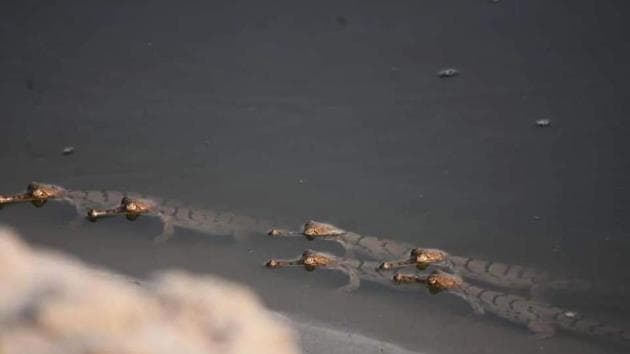Baby gharials return to Yamuna after almost a decade
This was a strong indicator that ghariyals had chosen the Yamuna as another natural habitat and the river could be a cornerstone in conserving bio-diversity if the work to clean it gained pace.
Much to the astonishment of environmentalists and wildlife enthusiasts, the ghariyals of the Chambal river have chosen in a big way to nest and breed in the Yamuna, one of the most polluted rivers.

The ghariyals nested and laid eggs in Etawah, near 30 km upstream of Yamuna at Bhaupura. On June 15, 43 juveniles emerged and swam in the river with the adults, drawing massive crowds from the villages.
Curious onlookers said two of the hatchlings died and 24 could still be seen on the banks and in the river.
Regional forest director Rajesh Kumar Verma said this was a heartening development. In order to protect the ghariyals, a team of forest guards along with volunteers from villages was deployed for round the clock monitoring.
Rajeev Chauhan, conservation officer with Wildlife Institute of India said it was surprising the ghariyals were breeding in the Yamuna. Way back in 2011, the ghariyals ventured in the Yamuna near Haraur village for breeding for the first time but by and large the amphibians remained in their natural habitat, the Chambal.
“The first reason that comes to my mind is that the lockdown has improved the water quality of Yamuna so the ghariyals have started moving to it in big numbers,” Chauhan said.
This was a strong indicator that ghariyals had chosen the Yamuna as another natural habitat and the river could be a cornerstone in conserving bio-diversity if the work to clean it gained pace, he said.
Even last year, ghariyals were seen in the Yamuna for breeding for the second time but on a much smaller scale, at a place where Yamuna and Chambal meet in Etawah near Sumer Singh fort.
This year their number had considerably risen, said experts. They said there had been one sighting of ghariyals nesting in Yamuna downstream in Sajeti of Kanpur rural.
After this discovery, the wildlife experts and enthusiasts have started a detailed study on this phenomenon with the help of their volunteers who are keeping a watch on ghariyals of Yamuna. Forest sub-inspector Tabish Ahmad said the experts had made the Bhaupura village their base to study and they were seeking help of the villagers.
“When I was first told about this I could not believe it. I stared when I saw the ghariyals swimming with juveniles. This is one of the best things to have happened in Yamuna and Etawah,” said Ahmad.
In 2007, an unspecified disease had claimed lives of more than 100 ghariyals in Chambal and their bodies were found in the Yamuna. Many experts from different countries conducted comprehensive researches, which included tagging transmitters, to find out of the cause and to help them in survival. One set of experts had blamed liver cirrhosis caused by high pollution level and another thought it was hunting.



